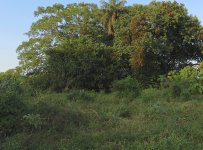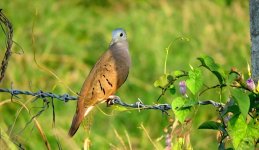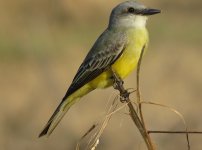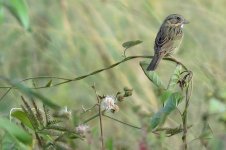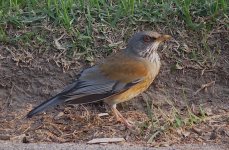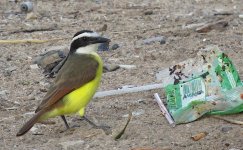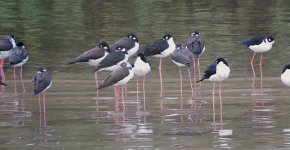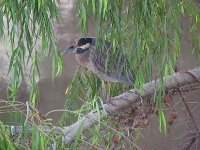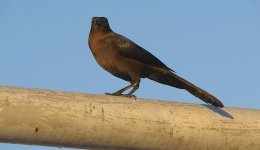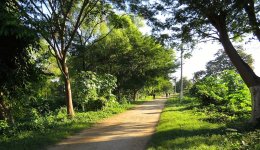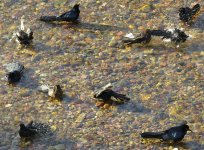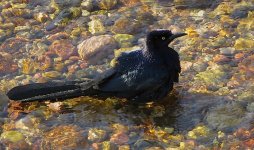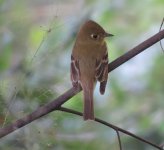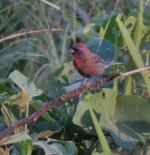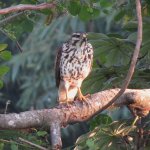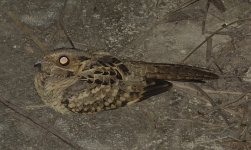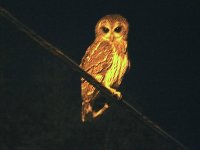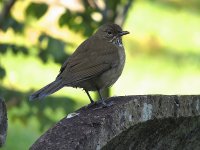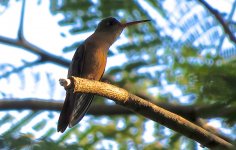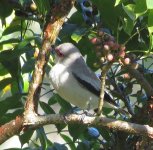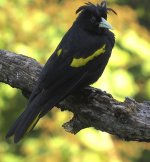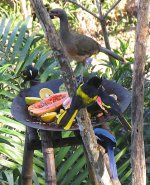MKinHK
Mike Kilburn

1 December
This flying visit to the Pacific coast of Mexico was built around a two day conference into which, this being my first visit to Mexico I was eager to cram in as much birding as humanly possible and still stay awake for the business part of the trip, all the while battling the killer jetlag of a 14 hour difference in timezones.
It started well with a daytime flight south from LA and along the west coast of Mexico, passing over some glorious–looking coastal wetlands and seeing the ghosts of others in the remnant oxbow lakes among the fields.
Arriving In Puerto Vallarta over the mountains that surround the town I was slightly disturbed to see two large raptors with a distinctive white spot in an otherwise dark wing pass just one or two hundred metres below the plane about one minute from landing - Crested Caracaras - and, as we taxied back from the runway, the first Turkey Buzzard of the trip floated majestically across the runway on which we had just landed. There were also four or five Great-tailed Grackles and numerous other small and unidentifiable birds in the grassy fringes, all auguring well for the next few days.
Having checked into the Fiesta Americana hotel I was rather blown away by the group of 20-odd Magnificent Frigatebirds cruising casually over the beachfront and even the pool – often coming to within ten metres of the building! Looking a bit further out to sea numerous splashes hinted at a healthy population of dolphin (they are Bottle-nosed here) , and even better a couple of adult Blue-footed Boobies wandered a little offshore from the frigatebirds and the odd Brown Pelican.
I had seen some patches of promising looking habitat (immediately to the south of the Rio Pitillal) from the taxi as we approached the hotel, and with ninety minutes of daylight remaining I walked back north to see what I could dig out. A score or more of Great-tailed Grackles and eight wonderfully prehistoric Groove-billed Anis were all over the roadside verges and as I ducked under the barbed wire and onto a the remnants of a grassy track that headed towards a line of trees the birds started appearing almost immediately.
First up was one of many yellow and grey warblers that perched long enough for me to see a dark mask, broken eyering and grey breast that I eventually worked out was a male MacGillivray’s Warbler. Having had extremely limited exposure to the American warblers previously this group provided an enjoyablechallenge that I slowly unraveled over the course of the stay, adding several Nashville Warblers and the more distinctive Blue-grey Gnatcatcher, but also having to leave plenty more unidentified.
The next conundrum were a number of heavy-billed finches in dowdy winter plumage that eventually revealed themselves as Blue Grosbeaks – which proved to be abundant in the scrubby habitat. More exciting, and surprisingly easy to see were a group of 20-odd Mexican (aka Blue-rumped) Parrotlets(E) discussing their day among the upper branches of one of the larger trees, which they shared with a couple of impressively large Iguanas, loafing utterly immobile among the branches, and a roosting Great Blue Heron that ignored me completely despite being less that 20 metres away.
I was delighted to find a couple of Vermillion Flycatchers perched close to the path; first a subdued female: ochre-bellied, grey-backed, dark-tailed and streaky-breasted and then the staggeringly bright red male. This beautiful but common species has great sentimental value as it was first described to me by my Mexican penfriend from her garden using the local name of brasita de fuego – the burning ember – some 25 years earlier.
A larger olive-coloured bird that popped up onto a weed stem showing a black moustache, white brow and throat was the first of some 30 Grayish Saltators, which kept dropping off the top of the trees and into the further line to the north and I had my first Great Kiskadee (a giant yellow-bellied flycatcher with a rufous tail and humbug-striped head), a pale bellied Ashy-throated Flycatcher and a couple of Tropical Kingbirds in a rather bewildering but wonderful two minute introduction to large flycatchers.
On the deck first a grey-faced Lincoln’s Sparrow and then a very showy ginger-browed Grasshopper Sparrow popped up and sat long enough to be photographed before disappearing back into the long grass as a couple of tiny Inca Doves, long-tailed and delicately scaled flew up from the path (and reminding me to include the several White-winged Doves that scooted overhead). During this time I was unable to pin down a whistling raptor-like call high in the trees, but this did draw my eyes to a pair of Black Vultures, a trio of Turkey Vultures and an Osprey consuming a new caught fish as it enjoyed the last rays of the sun. I lingered into the dusk, hoping unsuccessfully for an owl or nightjar but headed back to the hotel capturing one final oriole sp. as the gloom deepened.
Cheers
Mike
This flying visit to the Pacific coast of Mexico was built around a two day conference into which, this being my first visit to Mexico I was eager to cram in as much birding as humanly possible and still stay awake for the business part of the trip, all the while battling the killer jetlag of a 14 hour difference in timezones.
It started well with a daytime flight south from LA and along the west coast of Mexico, passing over some glorious–looking coastal wetlands and seeing the ghosts of others in the remnant oxbow lakes among the fields.
Arriving In Puerto Vallarta over the mountains that surround the town I was slightly disturbed to see two large raptors with a distinctive white spot in an otherwise dark wing pass just one or two hundred metres below the plane about one minute from landing - Crested Caracaras - and, as we taxied back from the runway, the first Turkey Buzzard of the trip floated majestically across the runway on which we had just landed. There were also four or five Great-tailed Grackles and numerous other small and unidentifiable birds in the grassy fringes, all auguring well for the next few days.
Having checked into the Fiesta Americana hotel I was rather blown away by the group of 20-odd Magnificent Frigatebirds cruising casually over the beachfront and even the pool – often coming to within ten metres of the building! Looking a bit further out to sea numerous splashes hinted at a healthy population of dolphin (they are Bottle-nosed here) , and even better a couple of adult Blue-footed Boobies wandered a little offshore from the frigatebirds and the odd Brown Pelican.
I had seen some patches of promising looking habitat (immediately to the south of the Rio Pitillal) from the taxi as we approached the hotel, and with ninety minutes of daylight remaining I walked back north to see what I could dig out. A score or more of Great-tailed Grackles and eight wonderfully prehistoric Groove-billed Anis were all over the roadside verges and as I ducked under the barbed wire and onto a the remnants of a grassy track that headed towards a line of trees the birds started appearing almost immediately.
First up was one of many yellow and grey warblers that perched long enough for me to see a dark mask, broken eyering and grey breast that I eventually worked out was a male MacGillivray’s Warbler. Having had extremely limited exposure to the American warblers previously this group provided an enjoyablechallenge that I slowly unraveled over the course of the stay, adding several Nashville Warblers and the more distinctive Blue-grey Gnatcatcher, but also having to leave plenty more unidentified.
The next conundrum were a number of heavy-billed finches in dowdy winter plumage that eventually revealed themselves as Blue Grosbeaks – which proved to be abundant in the scrubby habitat. More exciting, and surprisingly easy to see were a group of 20-odd Mexican (aka Blue-rumped) Parrotlets(E) discussing their day among the upper branches of one of the larger trees, which they shared with a couple of impressively large Iguanas, loafing utterly immobile among the branches, and a roosting Great Blue Heron that ignored me completely despite being less that 20 metres away.
I was delighted to find a couple of Vermillion Flycatchers perched close to the path; first a subdued female: ochre-bellied, grey-backed, dark-tailed and streaky-breasted and then the staggeringly bright red male. This beautiful but common species has great sentimental value as it was first described to me by my Mexican penfriend from her garden using the local name of brasita de fuego – the burning ember – some 25 years earlier.
A larger olive-coloured bird that popped up onto a weed stem showing a black moustache, white brow and throat was the first of some 30 Grayish Saltators, which kept dropping off the top of the trees and into the further line to the north and I had my first Great Kiskadee (a giant yellow-bellied flycatcher with a rufous tail and humbug-striped head), a pale bellied Ashy-throated Flycatcher and a couple of Tropical Kingbirds in a rather bewildering but wonderful two minute introduction to large flycatchers.
On the deck first a grey-faced Lincoln’s Sparrow and then a very showy ginger-browed Grasshopper Sparrow popped up and sat long enough to be photographed before disappearing back into the long grass as a couple of tiny Inca Doves, long-tailed and delicately scaled flew up from the path (and reminding me to include the several White-winged Doves that scooted overhead). During this time I was unable to pin down a whistling raptor-like call high in the trees, but this did draw my eyes to a pair of Black Vultures, a trio of Turkey Vultures and an Osprey consuming a new caught fish as it enjoyed the last rays of the sun. I lingered into the dusk, hoping unsuccessfully for an owl or nightjar but headed back to the hotel capturing one final oriole sp. as the gloom deepened.
Cheers
Mike
Attachments
-
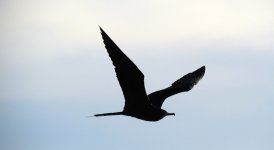 IMG_9758 Magnificent Frigatebird @ PV Mexico.JPG38.7 KB · Views: 62
IMG_9758 Magnificent Frigatebird @ PV Mexico.JPG38.7 KB · Views: 62 -
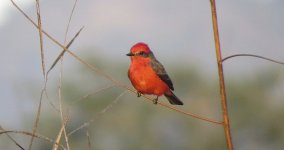 IMG_9767 Vermillion Flycatcher @ PV Mexico.jpg80.3 KB · Views: 63
IMG_9767 Vermillion Flycatcher @ PV Mexico.jpg80.3 KB · Views: 63 -
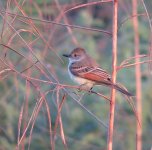 IMG_9770 - Ashy-throated Flycatcher @ PV Mexico.JPG216 KB · Views: 90
IMG_9770 - Ashy-throated Flycatcher @ PV Mexico.JPG216 KB · Views: 90 -
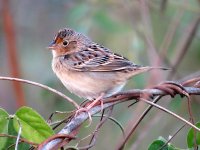 IMG_9781 Grasshopper Sparrow @ PV Mexico.JPG234.9 KB · Views: 62
IMG_9781 Grasshopper Sparrow @ PV Mexico.JPG234.9 KB · Views: 62 -
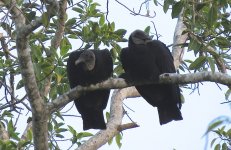 IMG_9765 Black Vulture @ PV Mexico.JPG268.7 KB · Views: 55
IMG_9765 Black Vulture @ PV Mexico.JPG268.7 KB · Views: 55
Last edited:




